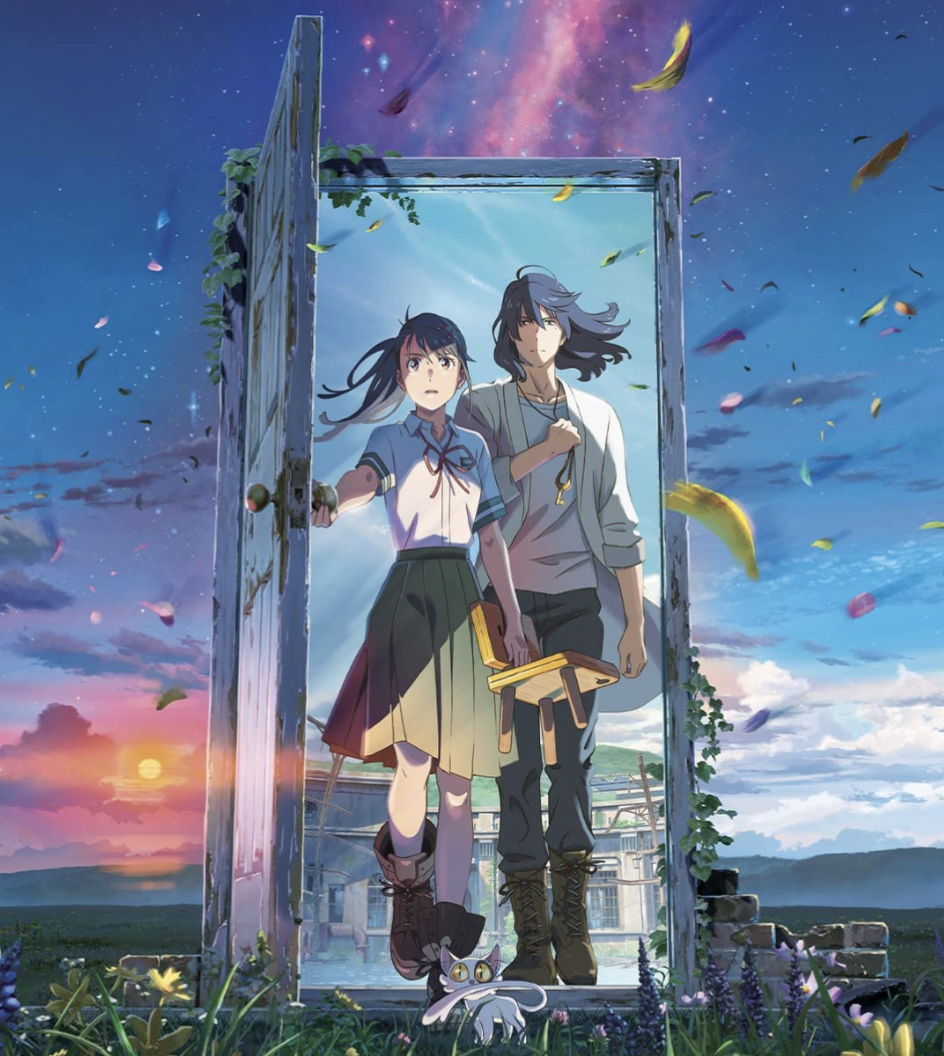
A child wrapped in a yellow scarf and red coat falls to her knees atop a dandelion-covered hill, the sound of her cries growing faint. She closes her eyes and lowers her head in an act of hopelessness, but the growing crunch of footsteps draws her attention. She looks behind her to discover a shadowy figure beneath a pastel orange and violet sky speckled with stars. Right as the two make eye contact, brilliantly-hued flowers blow between the two, and the scene shifts to show the eyes of a teenager in a bed full of bright linens open hurriedly with her mouth agape and a look of uneasiness resting on her face. This is how director Makoto Shinkai introduces his newest work, Suzume.
The film is named after its main character, Suzume, a high schooler leading a seemingly monotonous life with her aunt in southern Japan. Things change when she encounters Souta, a mysterious young man who Suzume follows to a lone-standing door with a dream-like world lying beyond it. After accidentally releasing the “keystone,” a magical force stabilizing the supernatural world, Souta and Suzume set off to find and lock all of these open doors before the evil that they contain can escape.
From its first moment to its last, Suzume is a visual masterpiece. A vibrant color palette pairs with meticulously detailed landscapes to fashion scenes that are as ethereal as they are naturalistic. Shinkai makes especially good use of light and shadows which creates a sense of realism in even the film’s most dreamlike settings. The fluid animation is slightly disrupted by clunky CGI used to animate a giant evil worm, however, its appearances are brief and take little from the greater viewing experience.
The film has an effervescence which is enhanced by a Kazuma Jinnouchi and RADWIMPS-produced soundtrack, the latter having also worked on Shinkai’s latest two entries. Instrumentation and moods vary, though each track feels tailored to its exact moment. Moments before near-certain calamity are filled with awe-inspiring choral synths, while light-hearted cat chases showcase dizzying saxophone solos. The standout track, however, is the film’s recurring theme, “Suzume.” The song shares a hauntingly beautiful melody backed by a choir and resonant percussion, heightening the emotion in each of its appearances.
The supernatural forces and characters at play in Suzume are layered in mystery, which gives each reveal a sense of reward. This ranges from Suzume’s elusive backstory (that’s only fully shown in the film’s final moments) to the very nature of the doors she’s closing. The juxtaposition of an otherwise normal Japan elevates the film’s mystique.
It’s also true, however, that longtime Shinkai-viewers might find Suzume’s structure familiar, as the director uses a three-act approach similar to his previous two works. The first act lays the groundwork of the supernatural forces at work while introducing its two main characters. In Your Name, this is when an inexplicable link is formed between the two leads, as the sparse thread of otherworldliness begins to show itself. The second act marks a shift in intensity when the characters make a sacrifice to solve an emerging conflict, shown in Weathering With You by the remedy to the consequences of Hina’s powers. The third then sees the protagonist seeking to regain what was lost in a highly emotional conclusion. In Suzume, this is marked by the protagonist returning to the origin of her inner battle.
This formula delivers a captivating plot line and enhances the drama, though it also creates a sense of predictability. Just as Shinkai made the shift from films grounded in realism to imaginative fantasies, he should consider experimenting with new plot structures in his next venture.
But what sets Suzume apart is its mature set of themes, including trauma and the complexities of healing. This film depicts Suzume's physical journey across Japan, however, her emotional journey possesses a greater importance. Suzume makes new friends everywhere she travels who become integral support during country-wide search. The love and kindness these friends share ultimately prepares Suzume to face the film’s greatest conflict, her own deep rooted pain.
That’s because Suzume is truly about the 2011 Tohoku earthquake. Hints mount throughout the storyline, however, the reveal of Suzume’s backstory makes the film’s purpose explicit. More than anything else, this film reckons with the fact that over ten years have passed since the disaster, yet the emotional damage it wrecked continues to preside in the hearts of many. Ultimately, the film poses the question of how to move on from the pain this tragedy inflicted without dishonoring the memory of those who were lost.
Shinkai’s answer is found in the eternal place, the dream-like scene which exists beyond the doors. Like this realm, memories of the past may seem absent of trouble, enticing us to indulge in their pleasures. But Suzume shows this dream-world isn’t perfect, and relishing in it can cause disaster in the present. As Souta and Suzume honor the sites of the doors they close, our solution is to continue honoring these chapters of our lives, but ultimately close them.
While Suzume isn’t a perfect film, it does several things near perfectly. It exhibits a soundtrack equally alluring as its visuals, which synthesize to share a powerful message about what it means to heal.
In Suzume, Makoto Shinkai teaches that our past will always hold weight, but that this weight can strengthen us rather than hold us down.